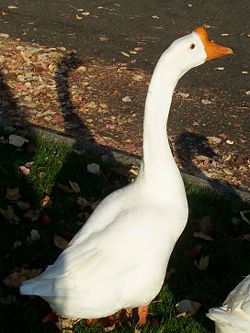Goose (domestic): Difference between revisions
Jump to navigation
Jump to search

imported>Stephen Ewen mNo edit summary |
mNo edit summary |
||
| (One intermediate revision by one other user not shown) | |||
| Line 1: | Line 1: | ||
{{subpages}} | {{subpages}} | ||
{{Image|GooseWhiteAmberglen1.jpg|right|250px|A domestic goose.}} | |||
The '''domestic goose''' is a domesticated species of the genus ''[[Anser]]'', kept as a food animal throughout the northern hemisphere. | The '''domestic goose''' is a domesticated species of the genus ''[[Anser]]'', kept as a food animal throughout the northern hemisphere. | ||
| Line 8: | Line 8: | ||
Goose eggs may be prepared in a similar way to [[chicken]] eggs, but are rarely eaten. | Goose eggs may be prepared in a similar way to [[chicken]] eggs, but are rarely eaten. | ||
Domestic geese are also sometimes used as guard animals. | Domestic geese are also sometimes used as guard animals.[[Category:Suggestion Bot Tag]] | ||
Latest revision as of 06:00, 23 August 2024
The domestic goose is a domesticated species of the genus Anser, kept as a food animal throughout the northern hemisphere.
Goose meat is usually served in the form of a whole goose, roasted. In England, a roast goose is a traditional centerpiece of a Christmas dinner. Goose liver, as foie gras, is an important ingredient in French cuisine.
Goose eggs may be prepared in a similar way to chicken eggs, but are rarely eaten.
Domestic geese are also sometimes used as guard animals.
